The John and Louis Rektorik Families
As the Frank and Marie Rektorik family settled into farm live and the number of their children increased, the responsibilities of the two eldest sons also increased. Their formal schooling would be cut short because they were needed on the farm. Louis only attended school through the third grade. Years later Louis would still recall how he and John had to mend the fences after they were maliciously cut by individuals who still harbored “anti-foreigner “ sentiments.
The year 1900 was seen through the eyes of young adults by John and Louis. John was 22 years of age and Louis was seventeen. John was in love with a beautiful daughter of one of the long-term neighbors. Agnes Jalufka was the daughter of Ignatz (Ignac) and Agnes (Anežka) Holub Jalufka (Jalůvka). The Jalufka and Holub families are named as the founders of the Moravia, Texas, community. The Jalufkas owned the Moravia General Store which also included a bar and a dance hall. Taking full advantage of the educational opportunities available for women in Texas, Agnes attended the “The Female Department” of Baylor University. While Agnes majored in Music she also learned of the concept of “Temperance.” She and John Rektorik would not wed until she completed her education.
In a small Album in which each page is hand decorated with Victorian cutouts, is a verse written to Agnes from John Rektorik, it reads as follows:
Moravia, February 22, 1901
To my Sweet,
Dear Friend,
When the name that I write here is dim on the page
And the leaves of your album are yellow with age
Still think of me kindly, and do not forget,
That wherever I am I remember you yet.
I write these simple lines for thee,
Whenever you see them think of me.
Flowers of friendship never fade.
Your friend,
John Rektorik
Also in Agnes Jalufka’s album is a verse written to her by Louis Rektorik. It reads:
Friend,
I thought, I thought
I thought in vain at last
I thought I would write my name.
Your Friend,
Louis Rektorik
Moravia, 19th Feb. 1900”
John and Agnes would marry in 1902 and continue to live in the area of Moravia. John took on the job as bartender in the Jalufka’s family business. He was quite a dashing figure being tall with vivid blue eyes and a large waxed handle-bar mustache. It is likely that John enjoyed his job as bartender for he always like whiskey and the companionship of others. A son, Jerome, was born on September 03, 1903.
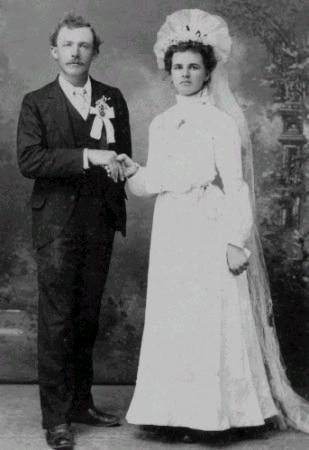
The wedding portrait of John and Agnes Jalufka Rektorik
The attention of Louis Rektorik would be caught by Johanna (Johana) (Janie) Hrncir, the daughter of John (Jan) and Veronica (Veronika) Šramek Hrnčiř. Josef and Anna Svoboda Hrncir, the parents of John Hrncir, had come to Texas on the eve of the American Civil War. They faced the Anti-Foreigner Sentiment and the conscription of their sons into the Confederate forces. They found some refuge in the area of High Hill, Texas, among the German Texans. After the war, with money earned hauling cotton to Mexico, the Hrncirs moved to the area of Moravia, and bought farm land. John was established on his own farm.
The love of Louis Rektorik and Janie Hrncir was such that when they chopped cotton, they took adjacent rows and when they reached the end of the rows, they would stop and kiss. Louis was tall and handsome with vivid blue eyes. Janie lovely with dark hair and eyes. Louis and Janie were married and Janie would soon become pregnant.
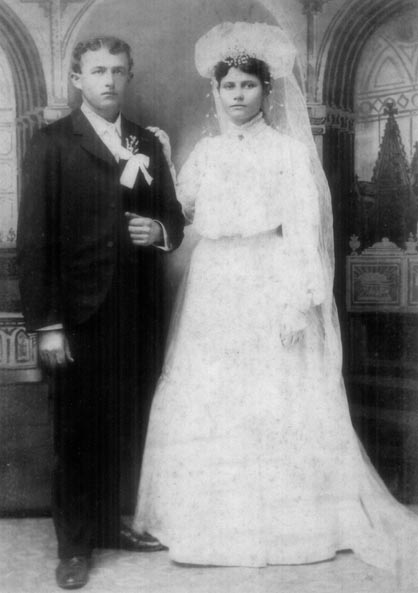
The Wedding Portrait of Louis and Janie Hrncir Rektorik
As is customary with the Moravian people, Frank established his sons on their own. The land of Lavaca County had been in production for many, many years. And, although the Czech farmers were noted for their land management skills, productivity was still declining in Lavaca County. Commercial fertilizers were not then available. As before, Frank would look beyond his immediate surroundings for good land.
Impetus for finding a new area in which to relocate his sons may have also come from a situation developing due to the employment of John Rektorik as a bartender. John’s wife, Agnes, knew the time that the bar closed and how long it took John to travel home. She frequently played the piano as she eagerly awaited his return. On evening, he was significantly late. Agnes became very worried. She hitched the horse to the buggy and drove towards Moravia hoping to find John. She did not meet him on the road and the store was locked and dark. Agnes went home thinking that she must have missed John in the dark. However, John was neither on the road nor at home. Again Agnes headed back to Moravia. This time, when she arrived at the store, she heard laughter in the distance. She walked around back of the store and there she saw John, Louis, and several of their friends with a keg of whiskey having a grand time. Her fear turned to anger. John immediately went home with her. Words were exchanged and the decision was made that there would be no more bartending.
This time Frank Rektorik looked to South Texas for land. As elsewhere, the coming of the railroads meant the opening of more land for development. In 1881, the Corpus Christi, San Diego, and Rio Grande Railroad completed construction of a railway that connected Corpus Christi, Texas, to Laredo, Texas. This railway had a section house about two miles east of the present location of Robstown, Nueces County, Texas. It was called Rogers. Then in about 1902, another railroad, then called the St. Louis, Brownsville, and Texas Mexican Railway, started a line to Brownsville and Robstown was established as a station for receiving material for construction.
Around 1904, a large section of what had been “The Famous Driscoll Ranch” and other ranch land was made available for development. The area of Robstown was included in this. Initially, the German-American Land Company marketed the land. Their efforts were not very successful and the George H. Paul Land Company of Washington, Iowa, took over the development.
Frank and several other local farmers, including Ignatz Jalufka, made an initial excursion to South Texas. They took the train from Laredo and viewed the land of the Texas Winter Garden area. Apparently this land was not acceptable to Frank and he went only as far as Alice, Texas. A possible explanation can be found in the old family story that Frank was told that there was no beer available in that area; and, where there is no beer, there are no Czechs!
A second trip was made around 1907. This time Frank viewed the land around Robstown and found it good. This area has a rich, waxy, black-clay soil excellent for farming. And, it had never been farmed so it was at its maximum potential. It was a magnet for the Czechs who knew for what to look.
Frank Rektorik and Ignatz Jalufka would select land to the northwest of Robstown. The Jalufka land was the first to the north of what is now County Road 44. The Rektorik land would the next north of the Jalufka land. The Jalufka and Rektorik land fronted what is now County Road 77. County Road 77 is still listed as “Moravian Road” on some maps.
“Running mesquite” covered most of the area. There was only a little growth above the ground but each mesquite had a vast and heavy root system. John, Louis, and the other early farmers cleared their land by hand, grubbing out the mesquite, and burning it. Some early settlers sought to avoid the intense labor and purchased tracts of land that were relatively clear of the mesquite. Over time, it would be learned that those tracts of land did not grow brush because they were in low areas that would stand water for months after heavy rains. This was before the drainage ditches were put in. It so happened that the Jalufka land was one of those that stood water for months. Over the years, that farm was rented by a number of young Czech farmers who were just getting started and despite the tendency to stand water, a saying developed that any young farmer that started on that farm would go on to be successful.
Back in Moravia, Janie, the wife of Louis Rektorik, gave birth to a son, George, on February 22, 1908. Tragedy would closely follow this joyous occasion. Janie sustained an internal tear during the delivery. An infection set in and since there were no antibiotics or other medications to help beat the infection, Janie died on April 02, 1908. Louis was devastated by the loss. A second great sadness was laid upon Louis when the families made the decision that it would be best if George was raised by his grandparents, Frank and Marie Rektorik. A certain sadness about these events in 1908 remained with Louis until his death in 1973.
Louis would focus on his farm and clearing the land. He also always had a friend in his brother, John. Soon after the Rektorik brothers started farming in Nueces County, they went by buggy to Robstown to purchase provisions. It was there that they were confronted by an extremely drunk Anglo-American. He pulled a gun and as he pointed it at the Rektoriks, he told his companion, “I ain’t never shot a Czech before!” Luckily, the companion was able to restrain the drunk man and no shots were fired.
The potential of Nueces County was also seen by Tomáš and Johana Marék Mrazék who had originally settled in Granger, Williamson County, Texas, after immigrating to Texas from Jablůnka, Vsetin, Morava. They arrived at the Port of Galveston in 1878 and traveled by cart and oxen to Williamson County. All of their goods were contained in a single, handmade, wooded chest put together with square nails. Twenty-nine years later, their trek to Nueces County would be quite different. They would travel by train and Johanna would carry a significant role of cash in her hand bag. They had sold their land, their home, and other assets in order to reinvest their funds in Nueces County. Johanna’s knuckles were white from clutching that handbag so tightly.
One of the daughters of Tom and Johanna was also named Johanna and she was called Jennie. Jennie relocated later than her parents as she had a job as a maid in Williamson County and the Mrazeks needed a place to live before all the children came to Robstown. Unlike the Rektoriks, the Mrazeks were blacksmiths and mingled with the non-Czech town community much more than did those Czech settlers who were farmers. The Mrazek girls always wore the latest fashions and Jennie would recall year later fretting about her new dress shoes being ruined by the muddy streets of Robstown.
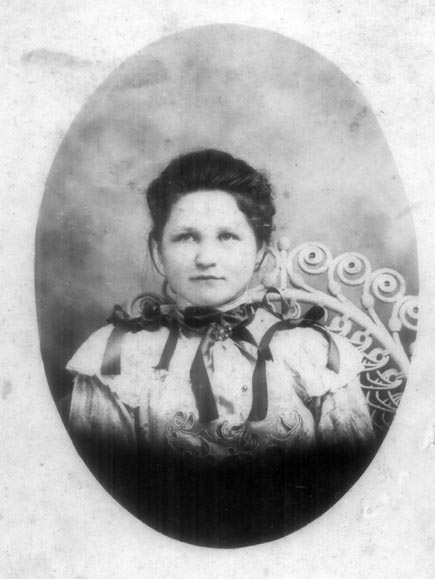
Johanna (Jennie) Mrazek
Jennie Mrazek was a striking beauty with dark hair and glorious blue eyes. Even through the depression at the loss of his wife and his separation from his son, Louis Rektorik was attracted to Jennie and they were married on December 15, 1910. In keeping with the sophisticated fashion trend, Jennie was married in an embroidered blue-silk gown. Three sons were born: Frank on December 17, 1911, Julius on May 04, 1913, and Edward on March 15, 1915. A daughter, Sylvia, was born to John and Agnes Rektorik on December 31, 1901.
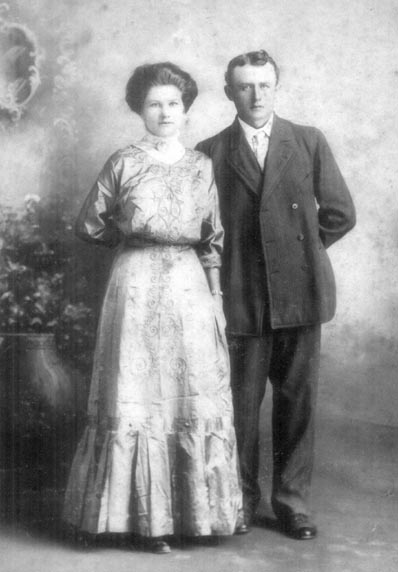
The Wedding Portrait of Louis and Jennie Mrazek Rektorik
A County School, Ward One, was built on the southwest corner of the intersection of what are now County Roads 42 and 77 on an acre of land donated by Mr. Adolf Berkovský. While the children of both Czech and Mexican settlers attended the Ward One School, English was the only language permitted and students were punished for “speaking Bohemian.” Years later Julius Rektorik would recall how when the girls heard the boys talking Czech (Moravian actually) on the school yard, they would run to the teacher yelling out, ‘The boys are talking Bohemian again!” The punishment was pulling weeds in the school yard. Julius lamented that he pulled a lot of weeds. His brother, Frank, recalled the same. However, with just a touch of a smile, Frank would also recall deliberately speaking Czech in school on cool, clear Spring mornings just so that he could spend time outside!
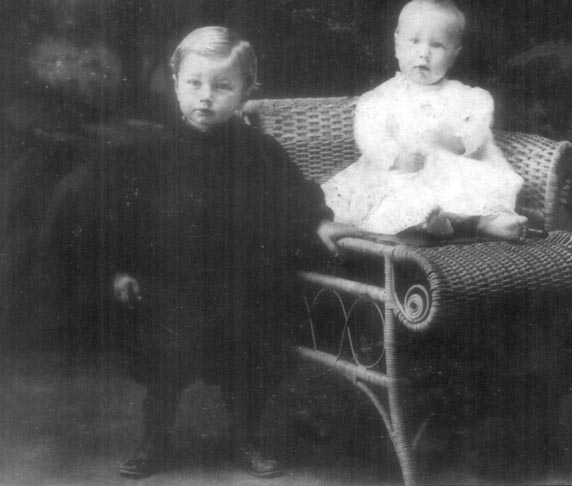
Frank and Julius Rektorik
The teacher for Ward One boarded with the Louis Rektorik family. She had one bedroom while the whole Rektorik family slept in the other bedroom. Jennie Rektorik did laundry and prepared the meals for the teacher. One teacher created a stir by galloping her horse to the school each day. Frank, Julius, and Edward would ride their horse, Jim, to school. Even years later, Julius would assert that he had the most difficult place on the horse. Frank sat in the saddle with Edward (also in the saddle) directly behind him. Julius had to sit behind the saddle and try to hold on as best he could. One afternoon, the Rektorik boys were challenged to a race. The course was agreed upon and the race on. The course went straight at the point where the boys usually turned to go home. They were at a full gallop and in the lead when Jim, who must have been tired of standing all day, decided to turn as he usually did. The horse turned but the boys didn’t. All three flew off the horse and tumbled to the ground.
For many years, the families of John and Louis Rektorik shared the farm work. Jennie, Agnes, and the children worked in the fields as well has having chores at home. Over time, life became easier. As in other places, the Czech settlers pulled together. Cooperative efforts by the local Texas Czech settlers would include the creation of the original “Moravian” Community Hall on County Road 42, and the Moravian Gin Co-op. There would also be local chapters of mutual aid and mutual protection societies. The Slovanská podporující jednota satu Texas (SPJST), known in English as the Slavonic Benevolent Order of Texas provided, and still provides, life insurance. The SPJST began operation in 1897. The Rolnický vzajemní orchranní spolek státu Texas (RVOS), later known as the Framers Mutual Protection Association of Texas, provided fire, lightening, and storm coverage to farmers when commercial coverage of farms was not available. The RVOS began operation in 1901. Also, over the years, Louis Rektorik was very active in the formation and operation of the first frozen food locker plant, the Nueces Electric Co-op, and the local Farm Bureau. He also served on the Robstown School Board and attended every high school football game, at home and away, for fifteen years.
Other children of Frank and Marie Rektorik came to Nueces County. The ones who came and stayed were: Annie (Anna) who married John (Jan) Blahuta, Jaroslav who married Agnes (Anežka) Janák, and Agnes (Anežka) who married Rudolph (Rudolf) Hrncir.
Another son, Joseph (Josef) married Mary (Marie) Blahuta and they too came to Nueces County and stayed for a while. However, they came during a dry spell, found that the well water did not agree with them, and missed family and friends very much. Jennie Rektorik told her granddaughter, Linda Rektorik, how it was decided that Joe and Mary would return to Lavaca County. Jennie said that Mary challenged Joe to a foot race. If she won, they would move back home; if he won, they would stay. Jennie Rektorik witnessed the race and was amazed when Mary grabbed her long skirts up and dashed out in front of Joe, kept the lead, and won.
When Rudolf Hrncir, Agnes Rektorik Hrncir, and their first-born son, Wilson, moved to Nueces County, they rented the Jalufka farm. The year was 1919, and this was Rudolph’s first crop. The extended Rektorik Family would have Sunday dinner together. On the morning of September 16, 1919,the Rudolph Hrncir family was at the home of Louis Rektorik. Jennie and Agnes were making kolaches. It had been raining since the day before and as the day progressed the showers turned into squalls and they knew they were in for a hurricane. Eventually the winds grew so strong that they thought the house might collapse, so they made their way to the garage which was constructed of concrete blocks. They sat in the Model T to be above the water. That same Sunday morning, John Rektorik was in his barn shucking corn when the hurricane hit. The wind was so strong that he had to crawl to the house.
By the next day, the storm had passed. When they left the garage they saw that the house and other buildings were still standing. They also saw that the cotton fields were flattened, the cotton ripped from the bolls, and standing in water. Rudolph silently observed the scene while he himself stood in the dirty, debris-filled water. "Rudolph, please say something!" beseeched Agnes again and again.
Not a word did Rudolph say. “If this is what life is like in South Texas, I think it would be best to move back to Moravia (Texas)!" is what Rudolph was actually thinking at that time...according to family lore. Rudolph and Agnes stayed. They had two more sons, Oscar and Eugene, and a good farm of their own.
John and Louis Rektorik delighted in technology. They each tried to outdo the other by getting something new first. Even when John and Agnes relocated to the area of Violet, Texas, there were strong bonds and connections. John and Louis visited, played cards and dominos, and drank together. There were spats; however, these two brothers remained friends until the end.
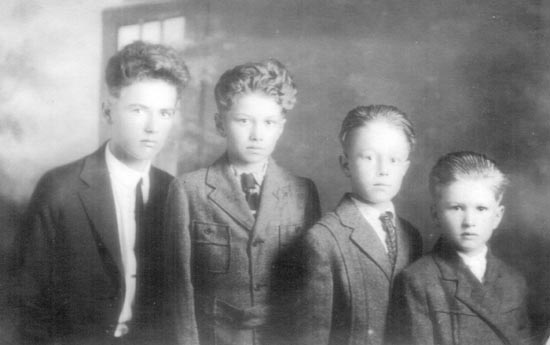
The sons of Louis Rektorik. From left to right:
George, Frank, Julius, and Edward